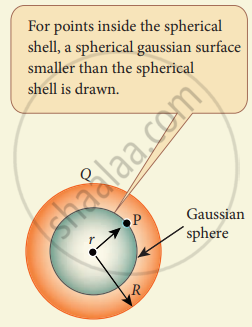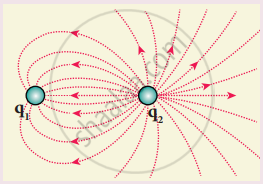Advertisements
Advertisements
Question
Obtain the expression for electric field due to an uniformly charged spherical shell.
Solution
Consider a uniformly charged spherical shell of radius R and total charge Q. The electric field at points outside and inside the sphere is found using Gauss law.
(a)
(b)
The electric field due to a charged spherical shell
Case (a):
At a point outside the shell (r > R): Let us choose a point P outside the shell at a distance r from the center as shown in figure (a). The charge is uniformly distributed on the surface of the sphere (spherical symmetry). Hence the electric field must point radially outward if Q > 0 and point radially inward if Q < 0. So we choose a spherical Gaussian surface of radius r and the total charge enclosed by this Gaussian surface is Q. Applying Gauss law,
`oint vec"E"*"d"vec"A" = "Q"/ε_0` .....(1)
The electric field E⃗ and dA⃗ point in the same direction (outward normal) at all the points on the Gaussian surface. The magnitude of E⃗ is also the same at all points due to the spherical symmetry of the charge distribution.
Hence, E\[\underset{\text{surface}}{\underset{\text{Gaussian}}{\oint}}\] dA = `"Q"/ε_0` ....(2)
But \[\underset{\text{surface}}{\underset{\text{Gaussian}}{\oint}}\]
dA = total area of Gaussian surface = 4πr2. Substituting this value in equation (2).
`"E"*4pi"r"^2 = "Q"/ε_0`
`"E"*4pi"r"^2 = "Q"/ε_0` (or) E = `1/(4piε_0) "Q"/"r"^2`
In vector form `vec"E" = 1/(4piε_0) "Q"/"r"^2 hat"r"` ....(3)
The electric field is radially outward if Q > 0 and radially inward if Q < 0. From equation (3), we infer that the electric field at a point outside the shell will be same as if the entire charge Q is concentrated at the center of the spherical shell. (A similar result is observed in gravitation, for gravitational force due to a spherical shell with mass M)
Case (b):
At a point on the surface of the spherical shell (r = R): The electrical field at points on the spherical shell (r = R) is given by
`vec"E" = "Q"/(4piε_0"R"^2) hat"r"` ....(4)
Case (c):
At a point inside the spherical shell (r < R): Consider a point P inside the shell at a distance r from the center. A Gaussian sphere of radius r is constructed as shown in figure (b). Applying Gauss law
\[\underset{\text{surface}}{\underset{\text{Gaussian}}{\oint}}\] `vec"E"*"d"vec"A" = "Q"/ε_0`
`"E"*4pi"r"^2 = "Q"/ε_0` ....(4)
Since Gaussian surface encloses no charge, So Q = 0.
The equation (5) becomes E = 0 (r < R) …(6)
The electric field due to the uniformly charged spherical shell is zero at all points inside the shell.
APPEARS IN
RELATED QUESTIONS
What is the ratio of the charges `|"q"_1/"q"_2|` for the following electric field line pattern?

Define ‘electric field’.
What is mean by ‘electric field lines’?
The electric field lines never intersect. Justify
Discuss various aspects of the electric field.
Obtain the expression for electric field due to an infinitely long charged wire.
Obtain the expression for electric field due to an charged infinite plane sheet.
